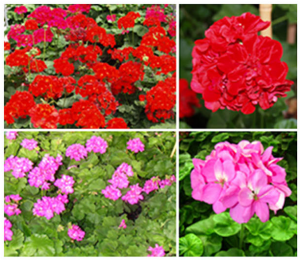You like pretty flowers but your immune system hates their pollen? You wish your pretty flowers would bloom for just that little bit longer? Well, science is making it happen.

In a new article published today in BMC Plant Biology, Begoña García-Sogo and colleagues from the Instituto de Biología Molecular y Celular de Plantas (IBMCP) and BIOMIVA S.L. in Spain outline a method to produce longer-lived and pollen-free Pelargonium plants – probably better known as geraniums or storkbills to the everyday gardener.
To do this, they employ the help of a soil-dwelling bacterium called Agrobacterium tumefaciens that can more usually be found infecting crop plants, where it induces damaging tumours known as galls.
But this pathogenicity is key.
In the wild, free-living Agrobacterium are attracted to wounds in plant cells, which they use as open windows through which to access the genomic goods inside. Once the plant is infected, these bacteria insert a small segment of their own DNA into the host plant genome to induce nutrient-rich tumours on which to feed.
This molecular cut-and-paste is what researchers have been able to harness, in order to insert target genes into target plants. Here, García-Sogo and the team turn the tables on Agrobacterium by inserting their own choice of target DNA into its genome through a process of electric shock treatment. They then use these transformed gall-formers as a living syringe to inject modified DNA into early cuttings of the host plant, which can be grown into full plants after they’ve been brewed up in a broth of bacterial soup.
Reasoning that most gardeners would wish their plants to live longer, the researchers chose as their DNA target a gene responsible for delaying the onset of aging by maintaining the production of a hormone called cytokinin. Once incorporated in the genome, the modified plants delayed the aging process by around two weeks compared to regular plants, and had the added benefit of more intensely coloured flowers.
A second gene was also incorporated into the mix preventing the development of the male reproductive organs, the anthers. This additional trait represents a boon to hayfever sufferers as these are the organs responsible for the production of the principle allergen involved, pollen.
This lack of pollen also renders the plants sterile.
And it is this sterility that should reassure those concerned about the risks of ‘escaping genes’ from artificially-modified to naturally-occurring plants. A lot of ink has been spilled on this issue, so it’s gratifying to see a good news story to brighten things up a little.
In the UK, these issues have recently come to the fore regarding field trials of wheat, modified to produce natural chemicals to deter greenfly. Despite a commendable effort by researchers at Rothamsted Research to communicate their rationale for the project – including the biological improbability of gene transfer in this crop– the trials came under threat of destruction from activists before they had even begun.
This current research highlights how—far from the stereotype of scientists meddling with nature—some wonderful benefits can be introduced to plants through simply employing the help of nature’s own genetic engineers, like Agrobacterium.
Better, more informed engagement on both sides of the horticultural fence will then allow us all to have more lovely gardens, fields and grocery-store shelves.

Read more about this research, including an interview with our Press team, here.
One Comment